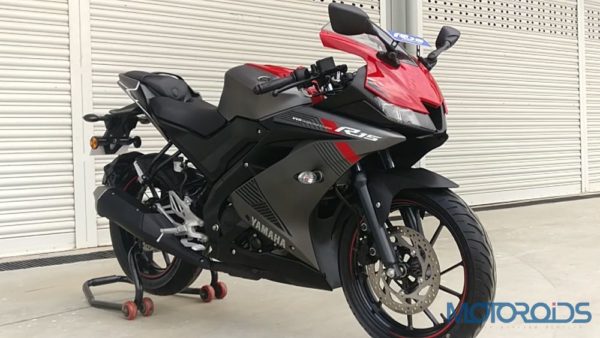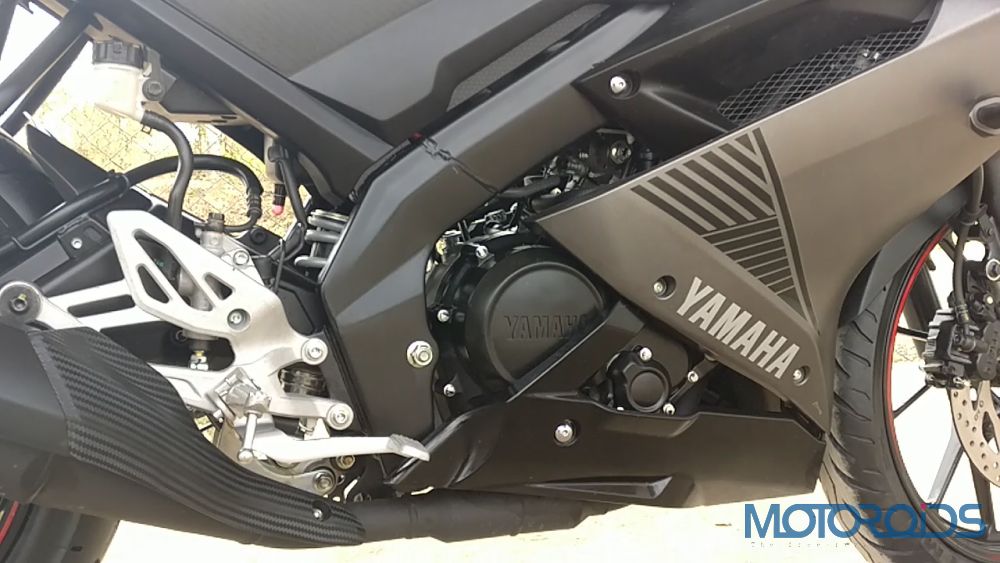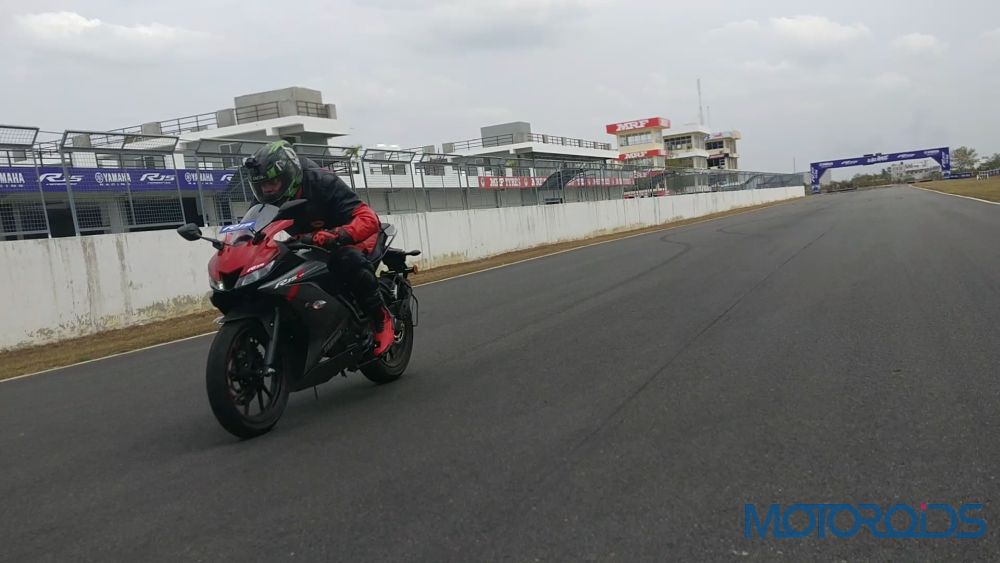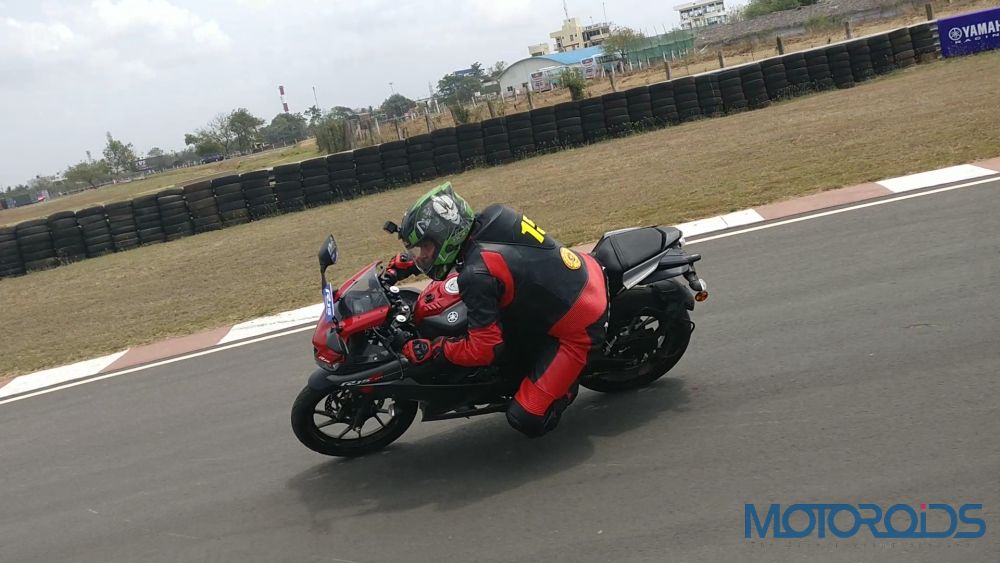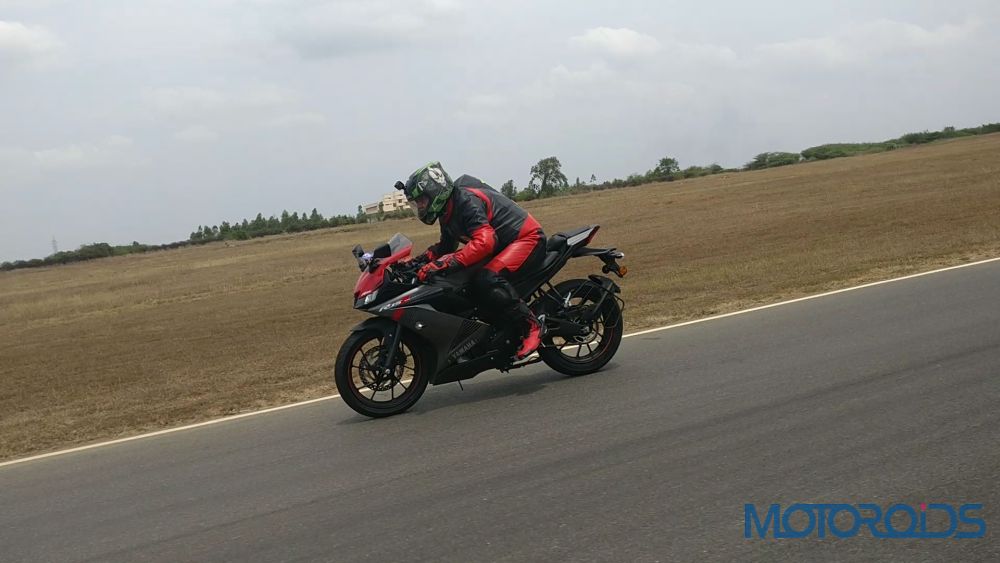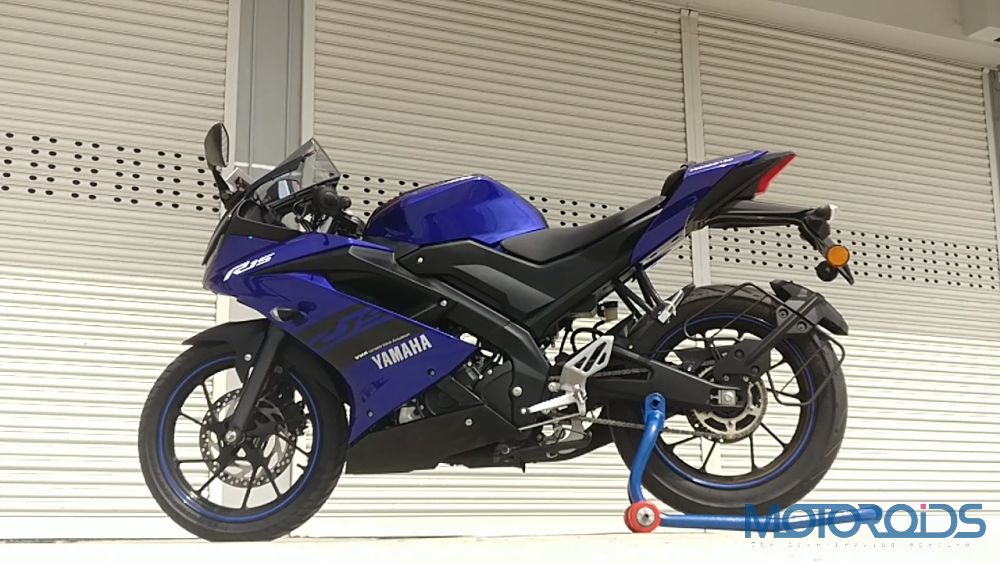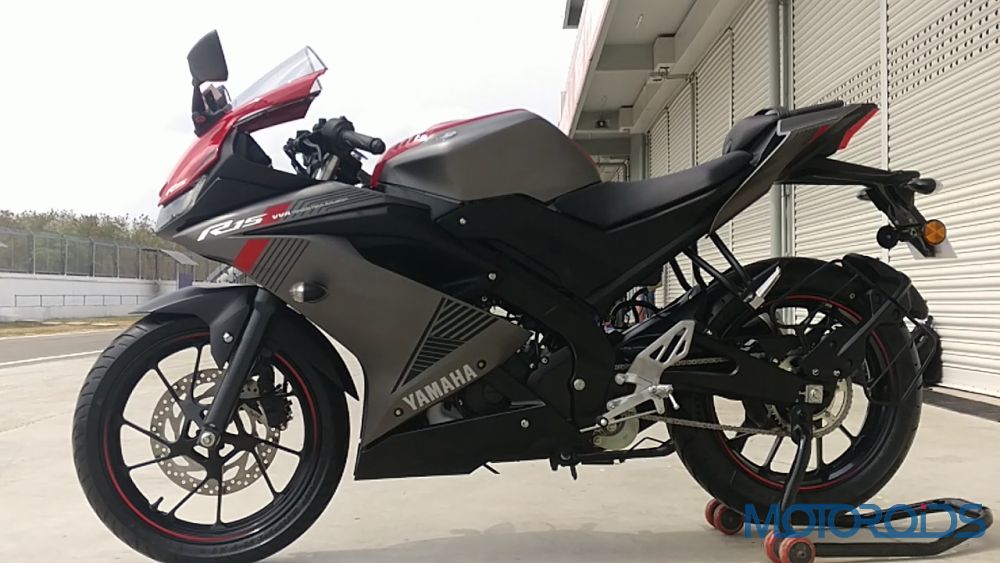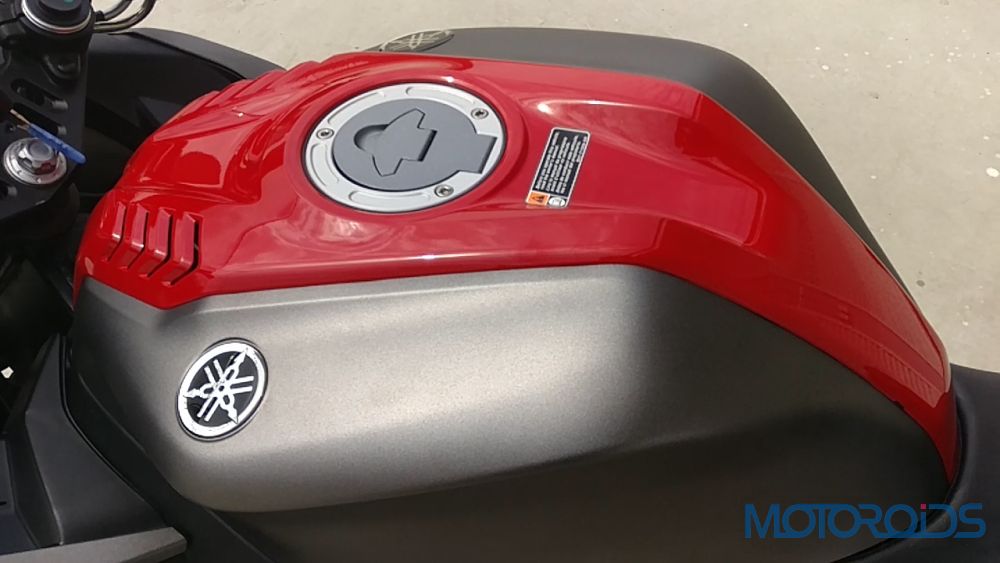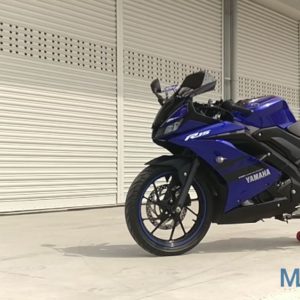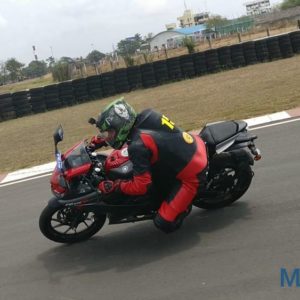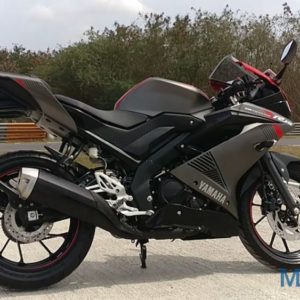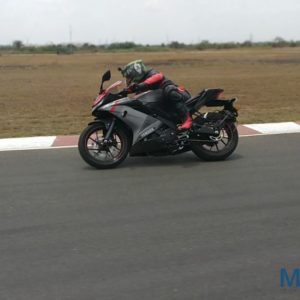The R15 V3 has been one of the most highly anticipated motorcycles for some time now, and after a long and excruciating wait, we have managed to review the motorcycle. A lot of facts related to the specs and features of the motorcycle have been available in the public domain for a very long time now – so in this review, we’ll try to focus on our experience with the bike, and try and answer some questions which weren’t hitherto answered. Let’s get going then with this very detailed review of the R15, which will be supported in places by videos for a more involving experience for you.
Yamaha R15 V3 Video Review
New Yamaha R15 V3 Engine and Performance
The new R15 is a significant improvement over the version it replaces from the engine, chassis, and technology perspective. The engine, at 155cc is now bigger, at 19.3 PS, produces more power, though the torque is the same as before at 15Nm, through it revs harder now. The VVA or variable valve actuation tech introduced on the bike actually works, and along with its fabulous high revs performance, we were floored by the low end smoothness and grunt of this machine, which would make it a fantastic city bike as well. The changes made to the bike’s engine and tech have been listed below, and have been explained in detail through a video featuring the real parts of the motorcycle, showcasing how they work and how they help enhance the bike’s performance. Here’s a list of the enhancements made to the R15 V3 over the V2
- New, bigger engine with more power and torque
- Variable Valve Actuation
- Slipper and assisted clutch
- A new warm-up system for the engine that brings it to optimum temperature quickly after start-up
- 60% bigger air cleaner than the R15 V2, now with a capacity of 5.5 litre for better air inflow and more volumetric efficiency
- Lighter connecting rod to allow the engine to rev freely and produce more power
- New, more powerful spark plug for better fuel combustion
- Redesigned profile for the cylinder head for better flame propagation
- New vents in the crank case to release back pressure and more efficient engine performance for lesser energy losses
- New 10 hole fuel injector for more uniform, cleaner combustion
- Diasil cylinder and forged pistons – as before
- Wider tyres – 100mm front and 140mm rear – 10mm increment at both ends
- Bigger 282mm front brakes with twin pot calipre for better braking, no ABS though
- Meatier 41mm front fork, as opposed to 33mm unit on the previous bike, although the upside down forks from the Indonesian version have been given a miss.
- The digital console is all new with features such as fuel efficiency display and customizable shifter light
- From a performance perspective you can also opt for Metzeler rear tyre which would cost Rs 10,000 and Daytona exhaust which has been priced at Rs 16,700
Here’s a video showcasing and explaining all that tech with help from real parts of the motorcycle
Now, on the move, every single one of those enhancements can be felt at work.
To start off, the performance from the engine is a marked improvement over the previous version. It feels significantly peppier off the block, and keeps building momentum all the way to 11500 revs where the limiter cuts in. The tractability at lower revs requires a special mention and even at revs as low as 2000 rpm in fourth gear, the engine feels knock free and smooth.
The momentum builds from 3000 rpm, and the progress thereafter is very linear, very refined and very reassuring. The vibe free, smooth nature of the engine and its rev-happy nature makes it suitable for everyday use as well as a rage-filled day at the track. We expected the top end to be strong, however, what floored us was the usability in lower and mid revs. The tractability, usability and smoothness in lower revs is really laudable for this sort of a motorcycle. The power is up by over 16%, with the efficiency also having gone up by 5%.
In terms of in-gear top speeds, the R15 does 48km/h in 1st, 74 km/h in 2nd, 98 km/h in third and 116 km/h in fourth gear, which means that you will have to slot into the fourth before you hit the ton, which would affect the bike’s 0-100 km/h time.
The top speed is claimed to be 145km/h internationally, though the new R15 seems to be genuinely capable of hitting the 140 km/h – which is fantastic for a 150cc machine. We’ll have to test the motorcycle on a long enough open road to test its top whack.
Power and torque gain can be experienced across the rev range, and the new R15 V3 is a significant step up in terms of performance over its predecessor. It’s a more evolved, more mature and more capable machine, and that fact is very clearly perceptible. Thankfully, despite the higher revving engine, there aren’t no vibes to be felt, nor has the motor given up on practicality. The performance has improved in every dimension, and that is something which is as pleasing, as it is laudable.
New Yamaha R15 V3 Ride and Handling
The bigger front forks, shortened wheelbase, reworked DeltaBox frame with a new sub frame and a new, lighter swingarm along with those wider tyres and a more aggressive riding position make the R15 a significantly more sure footed machine than its predecessor. I rode the motorcycle on the Chennai racetrack in 2008 when it was first introduced in India – the memories from that delightful ride experience are still fresh in my mind, and without an ounce of doubt, the V3 is significantly more sure footed.
Full Disclaimer: we were riding the Metzeler tyres, so we won’t be able to comment on the grip from the stock MRF rubber.
The grip from the Metzelers is astounding, and the R15 V3 is supremely sure footed for its class. It’s a focused machine and from a dynamic ability perspective, no 150 can even enter its ZIP code. The flickability on the motorcycle makes it a delight to lean from side to side aggressively, and the sweet chassis takes the extreme stress of the track in its stride in a forgiving manner, clearly exhibiting its capability to take a lot more abuse if you have the skills and fortitude for it. The slipper clutch comes in handy allowing you to go into a corner with late braking and even more aggressive downshifts, and the tech definitely makes its presence felt for the seasoned rider.
We would have liked the bike to have ABS, especially for the kind of audience it’s addressing. It would be nice if Yamaha offers the tech at least as an option in the time of come. The braking by itself however, is very reassuring, and the bigger discs do make a difference. Together with the wider tyres and the more capable chassis, the new brakes do a great job of dropping the anchors in a very reassuring manner. For a non-ABS unit, the front-rear disc brake setup offers great stopping power.
The rear suspension is a link type unit and is set on a slightly softer side for such a focused machine, which a good thing knowing that it’ll be used primarily on the street. The rear suspension is not adjustable, although despite being slightly soft, it performed exceptionally well on the track. There was not even a trace of the unwelcome wobbliness that mars many of those performance pretenders, exposing their weaknesses as soon as they set out on the track. For its size and capacity, the new R15 is a significantly better than the version it replaces, and is unfettered even at the very extreme of its dynamic performance.
New R15 V3 Ergonomics and Usability
To start off, the riding position is more extreme than the V2. The seat height has been increased, and you’re sitting at a height of 815 mm above ground. The ground clearance is also up by 10mm to 170mm now. For riders below 5’5″-5’6″ inch of height, that fact may spell some difficulty and planting their feet firmly on the ground may be more difficult than ideal. The handlebars have gone lower and all of that makes it a more committed motorcycle with a more aggressive stance. So if you’re looking for an easy going machine with a very friendly riding posture, probably this one is going to be a bit steep to adapt to. Riders who are used to a more upright riding stance will have to spend some time with the motorcycle to condition their arms, shoulders, wrists and legs to get used to the more aggressive riding position. Once your body gets used to the new riding position, though, there are benefits to be reaped, as the weight from your spine and back is released onto the legs and arms which is good for your spine from a long-term perspective.
The pillion seat has gone down by 30mm, and is not as awkward and uncomfortable to ride on as it was before. It also gets a grab belt, which should somewhat help. However, it still is not a very pillion friendly seat, and shorter users will still have problem getting aboard. It’s OK and usable within the city, however, for anything longer than a short city trip, that pillion seat is not recommendable.
The switchgear falls easily to the hand, and is easy to operate. It’s built well too.
The all-new digital instrument console offers tons of useful data and all of its features have been showcased in the video below.
New Yamaha R15 V3 Design and Build Quality
The R15 gets an R1 inspired front with a faux air intake, nice and aggressively styled panels, a sporty tail and LED tail lamps. Visually, the R15 looks fabulous. Of the grey-red and blue options, we’d pick the sportier looking grey-red any day. A lot of our users are moaning about lack of a black colour option, and we’re hopeful that Yamaha will address the complaint soon. Much has been said about the design, and we really don’t think there’s anything much to fault with the visual aspect of it. The bike looks fabulous and is the most striking 150 you can buy out there.
From a build quality perspective, there are two aspects to discuss. From the solidity of the build, the feel that you get when aboard and the way the bike feels when it’s on the move – you know that you are riding something which is impeccably engineered and very well put together. There’s not a squeak to be heard from any panel, and R15 feels like a motorcycle that’s been built to take a lot of abuse and last a lifetime.
However, in terms of finish and attention to detail, there are some rough edges. The quality of plastics on some panels, while not bad, isn’t in line with Yamaha’s exemplary standards. There are weld marks to be seen on the chassis components beneath the instrument console from the rider’s POV. Even the Deltabox frame bears some ungainly weld marks which should ideally have been smoothened out. Even the triple tuning fork logo on the tank feels somewhat rubbery to the hand, and doesn’t give you a very solid, reassuring feel.
So while we don’t have any doubts about the durability and engineering soundness of the new R15, some smaller aspects could probably have been paid more attention to.
You can also opt from a variety of accessories for the motorcycle, the details and prices of which are provided in the video below
Yamaha R15 V3 Exhaust Sound and comparison with Daytona Exhaust Sound
New R15 V3 Fuel efficiency
The iCAT efficiency for the bike is a little over 50 kmpl. no ARAI figures were provided to us. The test bikes, despite being run on the track were delivering around 35 kmpl, and while it’s not really possible to deliver a definitive word about fuel efficiency from the track, looking at the Fuel efficiency numbers from the instrument console, we think the new R15 V3 should deliver the worst efficiency of 35 and best efficiency of 45 kmpl, depending on how you ride it. For everyday use, expect the number to hover around the 40kmpl mark. Now, with the reduced tank capacity of 11 litres (as against 12 litres on the previous version) – the bike should have a range of a little more than 400 km, which isn’t bad at all.
New Yamaha R15 V3 Price
The Yamaha R15 is priced Rs 1.25 ex-showroom (as tested)
New R15 V3 warranty, service and running costs
The R15 V3 comes with a 2 year / 30,000 km warranty. As told to us by Yamaha officials, you’ll get 5 free services with no labour costs. The service schedule for the bike is 1000 km for the first service, 3000 km for the second service and 3000 km for every subsequent service.
The service costs for the first six services are provided below
| Service No. | No. of Days | Km | Maintenance Cost (Part + Labour) |
|---|---|---|---|
| 1 | 30 | 1000 | 664/- |
| 2 | 120 | 4000 | 664/- |
| 3 | 210 | 7000 | 864/- |
| 4 | 300 | 10,000 | 1577/- |
| 5 | 390 | 13,000 | 1249/- |
| 6 | 480 | 16,000 | 1014/- |
Based on this data, and taking an average efficiency of 40kmpl for calculations, with fuel cost of Rs 80 per litre, you’ll pay around 20,000 rupees on fuel for every 10,000 km ridden. Adding around Rs 4000 on average (paid+free) as service and maintenance costs, you’ll end up paying around Rs 24,000-25,000 per 10,000 kilometers you run this motorcycle for.
New Yamaha R15 V3 – Verdict
Is the new Yamaha R15 a better bike than the V2? Yes, and significantly so. Is it expensive? Looking at the goodies (slipper clutch, wider tyres, digital console, bigger brakes, more power, overhauled tech components) and upgraded tech it offers over the previous version, an increment of Rs 5,000 is as reasonable as it gets. No, it’s not expensive for what it does.
The Pulsar RS200 is a close rival, with more cubic capacity, more power and torque and same price (Rs 1.25 lakh) – however, the RS is heavier by 30 kg and horsepower to horsepower, it’s engineering doesn’t translate onto performance numbers as well as the R15. It’s a close call nonetheless, and you should take your pick based on what you want from your machine. The KTM RC200 is another fully faired option, but it’s way more expensive, at Rs 1.75 lakh ex-showroom, and isn’t quite in the same category as the R15.
If you like the R15 for what it represents, there’s nothing that should stop you from going ahead and buying this one. It’s a fabulous machine which justifies its price tag whichever way you look at it. Simply put, it’s the best 150cc machine out there, and by a mile!

